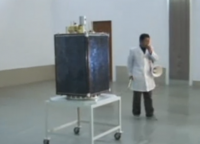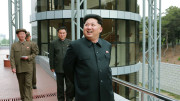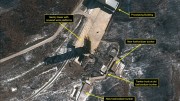 It’s been a day since foreign reporters were given a tour of North Korea’s Sohae launch facility. Stories have been filed, photos have been uploaded and video has been broadcast, so what have we learned?
It’s been a day since foreign reporters were given a tour of North Korea’s Sohae launch facility. Stories have been filed, photos have been uploaded and video has been broadcast, so what have we learned?
The man of the moment at the launch site was Jang Myong Jin, who was identified as general manager of the launch facility and widely quoted in reports. Jang repeated government assertions that the launch is peaceful in purpose and intended to launch a satellite.
“If it were a ballistic missile it would have to be hidden in an underground chamber, or would need to be carried on board another vehicle for protection. If it were not, then it would be useless in a real war,” he was quoted by Reuters as saying.
He would have a point if Sohae was believed to be a ballistic missile base — missiles are much less effective if your enemy knows their location — but the international worry is centered around it being a technology test for rocket systems.
At least two space experts appear to have been part of the media tour: James Oberg is a spaceflight operations specialist and spent 22 years at NASA’s Mission Control in Houston and is now space correspondent for NBC News; and Christian Lardier, a European analyst.
Not surprisingly, the two were quoted by other media outlets.
An independent European analyst who visited the launch site said he saw nothing obvious that raised red flags. “I don’t know what they want to do in the future, but today what we see is a space launcher,” said Christian Lardier. — CNN, “North Korea prepares controversial rocket launch,” April 9, 2012.
An American space expert accompanying a U.S. television network couldn’t hide his surprise at what he saw. He said he has never seen a satellite, stripped of its protective cover, put on display in such close proximity to onlookers. — Kyodo News, “A train trip to Tongchang-ri, N. Korea’s rocket launch site,” April 9, 2012.
A report on Zvezda TV, a channel run by Russia’s Ministry of Defence, said the satellite on show was a “replica,” according to a transcript of a broadcast report. But this wasn’t reported by any of the other media outlets at the launch site so it’s unclear if this was a claim of the North Koreans or the assumption of the correspondent.
[Update: In a Q&A on the NBC News website, Oberg said: “We asked whether this was a mock-up; in fact, we kept on asking them again and again because they insisted this was a real satellite.”]
Perhaps the most interesting report came from Oberg himself, who wrote on NBC News about some of the aspects of the site previously a mystery from satellite images — confirming some and correcting others. He wasn’t writing from the geo-political implications angle that dominated most news reports but as a space insider interested in the launch.
AP did add something to our knowledge of the satellite payload:
The satellite is designed to send back images and information that will be used for weather forecasts as well as surveys of North Korea’s natural resources, Jang said. He said a western launch was chosen to avoid showering neighboring nations with debris. He said two previous satellites also named Kwangmyongsong, or Bright Shining Star, were experimental, but the third will be operational. — AP, “Rocket in position at launch pad in North Korea,” April 9, 2012
This is interesting on two fronts:
Assuming the satellite makes it into orbit, people are going to be listening for signals from the craft. If a recognizable song is received it would be pretty conclusive proof of a successful launch and deployment of the satellite. Data signals, perhaps of image data or craft telemetry, would be more problematic because they would need to be decoded to prove their source was Kwangmyongsong-3 and not some other satellite in the same patch of sky.
It’s also interesting to see the differentiation between “experimental” and “operational” satellites. North Korea claims to have launched two satellites in the past, but there has never been a single trace of either. Governmental, military and civilian monitors in numerous countries have never reported a signal, sighting or radar reflection off either craft. The country maintains they both launched and were successful.
One other tidbit: Several reports mentioned that journalists were not allowed to take computers or mobile phones with them on the 5-hour train journey to the launch facility.
Finally, some video from Reuters TV:




